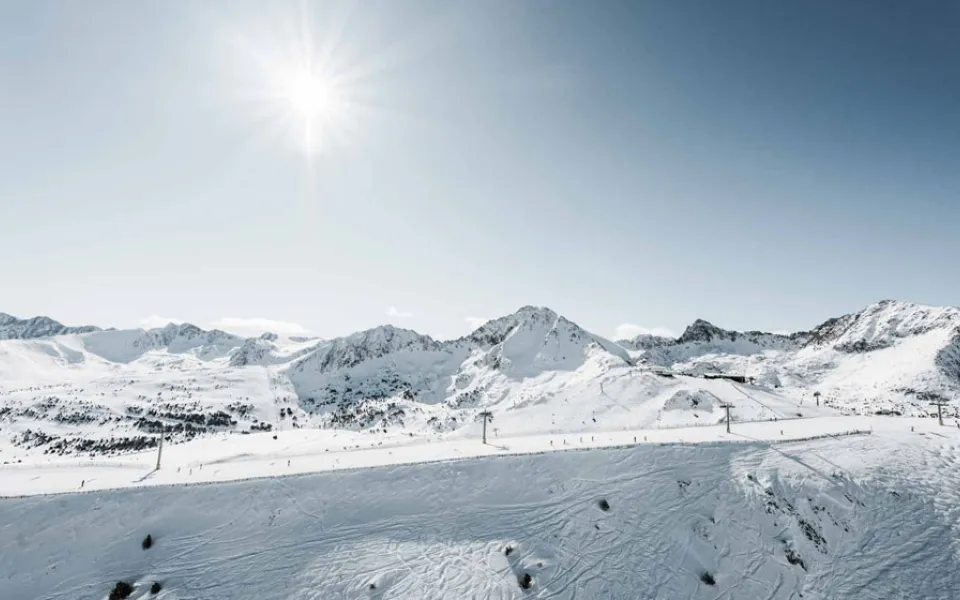
When you think of winter wonderlands, images of snow and ice immediately come to mind and so too might pictures of glaciers, the huge ice formations associated with the coldest environments on Planet Earth. But, what is a glacier exactly? Also, how are glaciers formed and where are glaciers found? That’s what we’ll go through in this guide to what is a glacier.
The first thing to note is that the study of glaciers is called glaciology, which is a science that brings together geology, geography and several other fields. So, when we want to understand what a glacier is in geography, that’s where the glaciologists come in.
As for the most standard definition of what is a glacier, the Britannica Encyclopaedia has one and states: “A glacier is any large mass of perennial ice that originates on land by the recrystallisation of snow or other forms of solid precipitation and that shows evidence of past or present flow.” Below, we’ll break down what exactly that means, and go through some glacier examples.
The formation and evolution of glaciers
The formation of a glacier typically requires high enough snowfall in winter, an average annual temperature which is close to zero and the absence of too much melting of the winter snow accumulation. Then, the continual accumulation and packing of snow over time results in a mass that is so big that it can become an ice glacier.
The above, of course, is the ‘What is a glacier?’ short answer. So, if you need to understand what is a glacier in geography exams then it’s worth looking into the formation and evolution of glaciers deeper, given that there are many nuances. But, the above is a simple explanation for how the process takes place over a long period of time.
Types of glaciers found around the world
There are two main types of glaciers around the world, and these are alpine glaciers and continental glaciers. The general background is the same for both, but there are a few key differences which we’ll outline here.
Let’s start with the question of what is an alpine glacier. Well, alpine glaciers generally originate in mountainous areas, and their flow is driven by gravity and dictated by the shape and slope of the surface. There are various types of alpine glaciers, including a mountain glacier, a valley glacier, a hanging glacier, a cirque glacier and much more. You might be wondering what is a cirque glacier, as this is quite a common term in this field, and a cirque glacier is when a glacier forms in a bowl-shaped depression on a mountain.
As for what is a continental glacier, a continental glacier is one which covers a much vaster area of land. They form when snow builds up over time and continues to pile up because the region doesn’t warm up much at all in the summer. In such a circumstance, the snow keeps building and building and, eventually, the ice glacier forms under its own weight. Although continental glaciers covered a lot of the planet in the past, nowadays they are only present in the extreme polar regions.
Famous glaciers to visit and explore
Let’s move on to some glacier examples and stick with the matter of what is a continental glacier first of all. Nowadays, Planet Earth has just two continental glaciers and these are the Antarctic Ice Sheet and the Greenland Ice Sheet. These two glaciers alone account for approximately 99% of the planet’s glacial ice, so they definitely count as famous glacier examples.
That said, it’s much easier to visit alpine glaciers, given how hard and costly it is to travel to the extreme polar regions. Some of the most famous alpine glaciers include Quelccaya Ice Cap in Peru, Perito Moreno in Argentina, Pasterze in Austria and the Glacier National Park in Montana, USA.
If you’re planning a ski holiday in Andorra, you might also want to know does Andorra have glaciers? Well, Andorra does have many glacial features, as the European microstate is located in one of the most mountainous regions in the world, where there was a lot of glacial activity during the Quaternary period. Nowadays, you can see a lot of the glacial features of Andorra from the Collet de Montaup viewpoint.
How climate change impacts glacier retreat
While the glaciers of the world are spectacular, many of them are in danger. That’s because climate change has a major negative impact on glacier retreat, the term for when a glacier shrinks in size.
The rising temperatures on Planet Earth mean that one of the key conditions for glacial formation and conservation no longer exists in as many parts of the world as it used to. Glaciers don’t just require large amounts of snow and cold winter temperatures, as there is also a need for a stable low temperature all year round and this no longer exists in the environments where some of the world’s most spectacular glaciers are found. The result is that these glaciers are starting to melt.
The future of glaciers is something of a mystery, and a concerning one at that. For now, though, we hope you’re enjoyed learning a little about the history of glaciers, about what is a glacier and about a few of the most famous glacier examples, both of alpine glaciers and continental glaciers.
